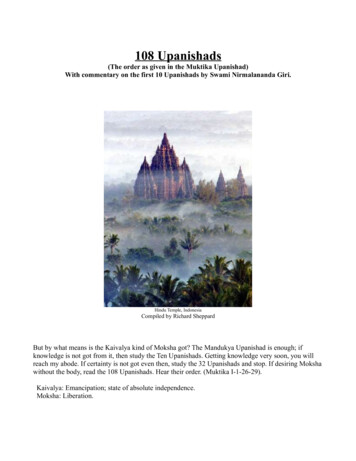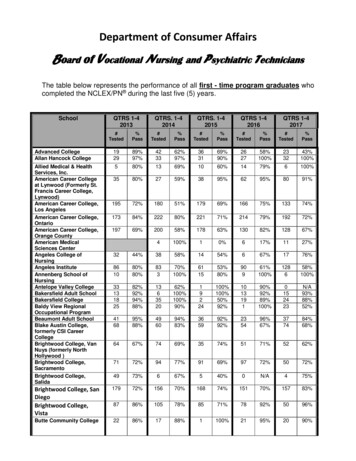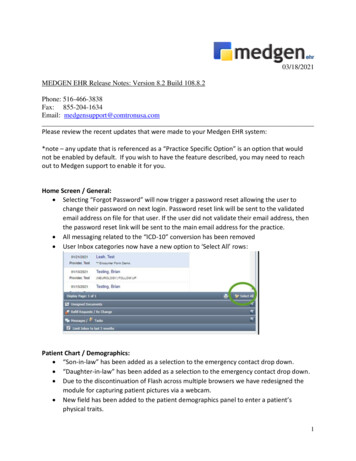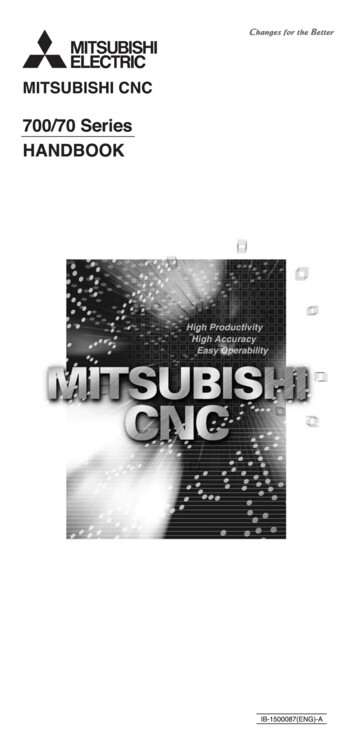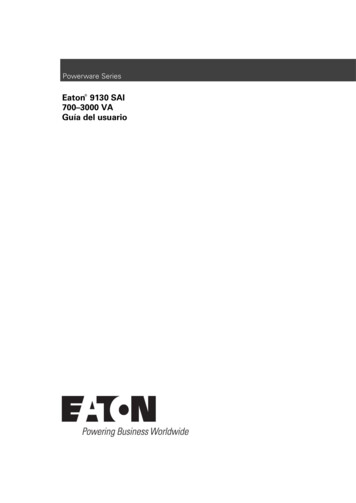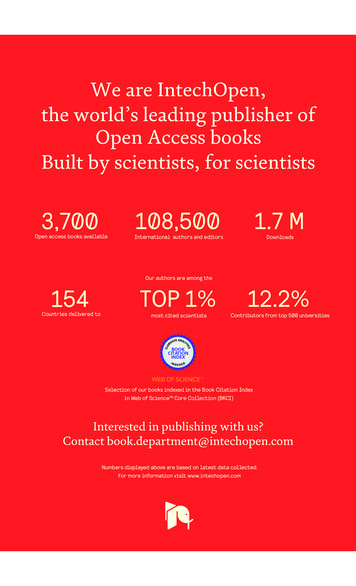
Transcription
We are IntechOpen,the world’s leading publisher ofOpen Access booksBuilt by scientists, for scientists3,700108,5001.7 MOpen access books availableInternational authors and editorsDownloadsOur authors are among the154TOP 1%12.2%Countries delivered tomost cited scientistsContributors from top 500 universitiesSelection of our books indexed in the Book Citation Indexin Web of Science Core Collection (BKCI)Interested in publishing with us?Contact book.department@intechopen.comNumbers displayed above are based on latest data collected.For more information visit www.intechopen.com
16Metallographic Etching of Aluminium and ItsAlloys for Restoration of Obliterated Marks inForensic Science Practice and InvestigationsR. KuppuswamyForensic Science Programme, School of Health Sciences, Universiti Sains MalaysiaMalaysia1. Introduction1.1 The problemA problem of common occurrence in forensic science is the restoration of obliterated serialnumbers on the chassis and engine of stolen motor vehicles, firearms, jewellery, valuabletools, and machinery (Nickols, 1956; Wolfer & Lee, 1960; Jackson, 1962; Cunliffe & Piazaa,1980; De Forest & Gaensslen, 1983; Schaefer, 1987; O’Hara & O’Hara, 1994; Moenssens et al(1995); Heard, 1997; Petterd, 2000; Lyle, 2004; Katterwe, 2006; Seigel, 2007; Mozayani &Noziglia, 2006; Jackson et al (2008); Levin, 2010). Serial numbers or other markings, whichare unique to that particular item, are usually marked on the above metal surfaces duringthe manufacturing process. Criminals alter or obliterate these identification marks duringthefts or other illegal uses in order to prevent their identity. On many occasions a fraudulentnumber would be introduced after removing the original one. In abandoned vehicles allserial numbers are verified in order to detect alterations in the identity of the vehicle(Svensson et al, 1981). Sometimes the serial numbers on firearms are removed moreprofessionally making it hard to distinguish whether the numbers are original or not(Shoshani et al, 2001). Restoration of the original obliterated numbers provides importantforensic evidence in order to return the items to the owner and also to follow up the criminalproceedings against the perpetrator. In cases involving firearms the recovered numbersprovide an important investigative lead. The history and the ownership of the firearm can beobtained only from the serial number. In forensic practice a few experimental techniques arebeing used successfully to restore the obliterated serial numbers on the above surfaces. Themethods include: chemical etching, heat treatment, magnetic particle, ultrasonic cavitation and reliefpolishing (Nickols, 1956; Polk & Giessen, 1989; Maxwell, 1993; Heard, 1997; Hogan et al, 2006;Katterwe, 2006). Nondestructive methods such as hardness testing, magnetic imaging, x-rayimaging, eddy current, infrared imaging, scanning acoustic microscopy, electron channelingcontrast and thermal wave imaging are also proposed (Hogan et al, 2005; Katterwe, 2006;Klees, 2009). However, chemical etching is most popular because it is sensitive, easy to applyon any size and also kind of object and reproducible. Etching can be applied on all metalsurfaces including precious ones (Crowe & Smith, 2005).This chapter presents background information on serial number restoration and etchingtechniques applied to recover the obliterated markings on aluminium and especially two ofwww.intechopen.com
332Aluminium Alloys, Theory and Applicationsits important alloys, Al-Zn-Mg-Cu and Al-Si. The etching results arising from some of thesesurfaces are illustrated. For the sake of completeness, some brief notes on the classicalrecovery of obliterated marks on iron and steel surfaces and use of methods other thanchemical etching are also added.1.2 Serial number marking methodsThe common methods of marking objects include: stamping, pin stamping, type wheel marking,engraving, laser etching and embossing (Collins, 1999; Petterd, 2000; Katterwe, 2006). Theserial numbering on motor vehicles and firearms is generally performed by stamping. In thisprocess the steel die bearing the digit is struck with a single stroke manually or using apressing machine. This causes an indented character. The amount of pressure applied percharacter to achieve a certain depth depends on the hardness of the metal surface. In pinstamping small pins are used to form individual dots on the substrate. Like in stamping,metal is being compressed beyond its elastic limit and a permanent impression is created.The impact pin is made of tungsten carbide and is driven rapidly toward the surface to bemarked. Pin stamping is applied to mark vehicle identification number (VIN). Type wheelmarkings are made in a hydraulic press with type wheels controlled by computers. This typeof marking is used by some automobile manufacturers with VIN. Engraving is a chip cuttingoperation where the substrate is cut away by a tiny spinning head leaving the marks. Laseretching uses an intense laser beam operated by a computer controlled system. Quality, depthand precision of laser marking are controlled by laser frequency, scan speed and Qswitching. Automobile components and modern firearms are currently being marked bylaser. The characters are usually shallow and they are visible to the eye only because theheat of the laser changes the appearance of the metal inside each character (Collins, 1999).Embossing is similar to die stamping, but used on thin plates. The die is pushed onto theplate from behind producing a raised appearance of the marks.1.3 Stress and deformation on the metalMetallurgical aspects of serial number recovery are described in (Turley, 1987; Polk &Giessen, 1989; Collins, 1999; Petterd, 2000; Katterwe, 2006; Hogan et al, 2006). The atomswithin metals of interest have a three dimensionally periodic crystalline arrangement withinlocal regions. These regions are called grains. Between the grains are interlocking regionsknown as grain boundaries. The strength of these boundaries relates directly to the strengthof the metal surface and its ability to resist stress. When a number is stamped onto a metalsurface using sufficient pressure, the metal is unable to resist it and a permanent change inshape takes place. The grains around and beneath the indented characters are deformed andthe alignment of the crystal structure is altered. This deformation known as cold work willnot only be confined to the crystals immediately below the character, but will extend to aconsiderable region below the impression. The deformation is carried deeper than the depthof the marking themselves. This can be referred to as zone of plastic strain. Thus, thestamping operation produces a visible indentation of the mark and a plastically deformedregion underneath it extending to a considerable depth. Significantly, an imprint of themark is latent below the visible indentation in the form of plastically deformed regions. Inother words, the region of plastic strain carries information of the stamped number and it iscrucial to number restoration in forensic investigations. Depth of this strain is dependent onthe metal, the size and shape of the die and the force used to produce the indentation.www.intechopen.com
Metallographic Etching of Aluminium and Its Alloys for Restorationof Obliterated Marks in Forensic Science Practice and Investigations333Experiments have demonstrated that in case of zinc the zone may run to depths of at least 20times the depth of the deepest character (Kehl, 1949), while in steel the affected region maybe six times as deep as the stamped mark (Thornton & Cashman, 1976). In cases of engravedmarks on steel and aluminium surfaces the depths of recoverable deformations variedbetween 2 and 3 times the depths of engraving (Azlan et al, 2007; Izhar et al 2008; Bong &Kuppuswamy, 2010; Uli et al, 2010).In cases of marks produced by pin stamping and engraving the depth of plastic deformationor strain is not as great as in stamping. Pin stamped and engraved characters, if obliterated,can be recovered but are more sensitive to the depth of erasure (Collins, 1999). Laser etchingon the other hand has no deformation but produces heat affected zone (HAZ). The depth ofthis zone will depend on the intensity of the laser and scan speed.The properties of the metals are known to change because of the altered crystalline structureof the metal during marking a number (Thornton & Cashman, 1976; Polk & Giessen, 1989;Hogan et al, 2006). The cold worked or deformed region has physical and chemicalproperties different from that of nondeformed metal. Important property changes are anincrease in hardness and decrease in ductility and yield stress. In addition changes occur inthe electrical resistivity, the magnetization behaviour of ferromagnetic alloys, the electronicwork function and the chemical potential among others. Every one of these propertychanges is used advantageously to detecting the plastically deformed regions that areresidually present after the visible indentations of serial numbers have been removed. Forexample, hardness differences are exploited in chemical etching, ultrasonic cavitation andrelief polishing, while differences in magnetic properties are utilized in magnetic particlemethod. Heat treatment applicable to cast iron substrates relies on the residual stressespresent below the stamped region (Kehl, 1949; Maxwell, 1988; Katterwe, 2006).1.4 Methods used for the removal of the markingsCriminals have used the following methods for the removal of the serial numbers: filing orgrinding, peening, welding and drilling (Cook, 1989; Heard, 1997; Petterd, 2000; Katterwe,2006). During grinding or filing the marks are usually removed till the base of metal so thatthe number would no longer be visible. If the erasure of the serial number does not go deepenough to remove the underlying plastic zone, the obliterated marks may be restored bysuitable methods. But, if the metal removal extends entirely into the plastic region, thenumbers cannot be recovered. Sometimes the perpetrator after grinding the area will polishit and substitute a false number. This process introduces a new deformation overlying theoriginal deformation.Occasionally, there will be no removal of metal by grinding but the marks will be defacedby peening so that they will not be discernible. This alteration involves hammering the markusing centre punch or cold chisel. The degree of deformation caused by peening can vary. Ifthe deformation caused by peening operation is localized or superficial recovery may bepossible.Drilling and welding of the area bearing numbers are also encountered. With drilling, theoutline of the numbers may sometimes become visible by careful polishing of the area andexamining it using a stereomicroscope under oblique lighting conditions. However, whenthe numbers are fused by welding, the recovery is almost impossible. Here the plastic straincarrying the original number would be relieved due to heating.Markings may also be converted using dies of similar size and style. For example, the digit 6can be changed into 8. A careful examination under magnification will reveal in such caseswww.intechopen.com
334Aluminium Alloys, Theory and Applicationsdiscontinuity of the outlines, unevenness of stamping and additional marks (Massiah, 1976;Kuppuswamy & Senthilkumar, 2004).2. Etching of metal surfaces for restoration of obliterated marksMacroetching techniques are probably the most informative and widely used for qualitycontrol, failure analysis and in research studies in material science (Vander Voort, 1984). Themechanical inhomogeneity in a metal caused by stamping or other marking process will bedetermined by macroetching the obliterated surface and examining the marks revealed withthe unaided eye or with the aid of a hand magnifier.A wide variety of chemical etching reagents for iron and steel and common nonferrousmetals and alloys are available in literature (Kehl, 1949; Nickols, 1959; Metallographicreagents for iron and steel, 1974; Massiah, 1976; Petzow, 1976; Vander Voort, 1984). Detailedetching procedures and time of etching are also compiled therein. Composition of the alloywill strongly influence the choice of a particular etchant.Before the etching process begins, the item should be photographed showing details of theobliterated area. If necessary, the area may be dusted with fingerprint powder and lifted withtape. The area should be degreased using alcohol/acetone before any surface preparation.2.1 Mechanism of etchingEtching is basically a controlled corrosion process resulting from electrolytic action betweensurface areas of different potential (Kehl, 1949; Vander Voort, 1984; Polk & Giessen, 1989).The etching solution does not act in a uniform manner on different faces of the crystals, oron different areas of the grain. The cold worked regions are known to be chemically morereactive, as the position of the deformed metal in the electromotive series is raised. Hencethey will dissolve in an acid at a more rapid rate than the surrounding unaffected regions(regions not affected by stamping). The desired result is a local change in reflectivity of lightthat reveals the obliterated marks (Polk & Giessen, 1989; Thornton & Cashman, 1976). Thusthe etching technique relies on the difference in the etching behaviour between thedeformed and undeformed regions in order to produce the desired image contrast.2.2 Surface preparationMetallurgical literature devotes considerable attention to specimen preparation before etching(Kehl, 1949; Vander Voort, 1984; Vander Voort, 1986). The steps mainly include grinding(using coarse abrasives) and subsequent polishing of the metal surface (using fine abrasives) inorder to study the microscopic structural characteristics. However in forensic practice the areaof the engine/chassis number of a car, for example, may contain a lot of scratches and gougescaused during the obliteration of the number. A careful microscopic examination withillumination from low angle will sometimes reveal traces of the numbers against the scratchesprior to any surface preparation (Matthews, 1962; Srinivasan & Thirunavukkarasu, 1996). Thepresence of the cutting marks, however, may interfere with the interpretation of the recoveredmarks during etching. Hence the obliterated surface should be made smoother by use ofemery papers of different grades starting from coarser grades and finishing with finer ones(Polk & Giessen, 1989; Katterwe, 2006). Careful polishing producing smooth finish free fromall grinding scratches is to be preferred. This is important as such scratches may affect thecontrast of the recovered number. However care should be taken that more metal that includesthe residual deformation zone is not removed during preparation stage.www.intechopen.com
Metallographic Etching of Aluminium and Its Alloys for Restorationof Obliterated Marks in Forensic Science Practice and Investigations335Sometimes the obliterated serial number plate of a firearm has to be removed and examinedfrom its back to reveal the negative impression caused by the stamping of the front side ofthe plate (Cooper, 2002).2.3 Etching techniqueChemical etchants are used at room temperature either by swabbing the sample orimmersing and gently agitating it (Kehl, 1949; Nickols, 1959; Massiah, 1976; Petzow, 1976;Vander Voort, 1984; Katterwe, 2006). The surface is swabbed by use of cotton-tippedapplicator. The cotton should be dipped regularly in fresh etchant and applied until thedesired contrast is obtained. The swab is moved slowly back and forth across the surfacewith gentle pressure. The surface is observed closely for the appearance of any marks.Swabbing is mostly preferred in number restoration, as it provides control over etchingtechnique. Immersion is preferred in cases where restoration is slow to developing. In suchsituations a small surround of plasticine is built around the obliterated area and the reagentis filled within (Nichols, 1959; Petterd, 2000). The reagent is removed at intervals andreplenished. Control of the etching time is important as the obliterated numbers wouldappear and disappear during the etching. While some restorations appear within minutes ofreagent application, others would take about an hour or more. Under-etching fails to revealthe obliterated marks, while over-etching destroys the recovered marks. As etching time andtemperature are closely related, it is desirable to do etching at room temperature.2.4 Photography of the recovered marksPhotography is the best method for permanent record of the restored marks. Photographicmethods are similar to those used for recording latent fingerprints and also documentsdealing with obliterations. Recovered marks are inherently very faint and the contrast withthe background would be usually poor. They can further be seen only at certain angles ofillumination. The examiner should be familiar with close-up and macrophotographictechniques. In cases of firearms where the specimen is relatively small, macrophotographyof the marks can be carried out in the photo-copying stand using appropriate illumination.However, when dealing with engine and chassis of cars the camera has to be set up on anadjustable tripod. Several exposures are to be made by shifting the light source so that itilluminates the surface from different directions. Black and white photography using highcontrast film may also help to bring out the faint outlines of the number. Light reflected by amirror may be advantageously used to record the faintly recovered digits. A combination offlash and available light sources is also recommended (Katterwe, 2006). Current digitalphotographic techniques provide greater advantage offering contrast enhancement softwareprocedures. Sometimes the area carrying the recovered marks was dusted with fluorescencefinger printing powders (Lightning Redwop and Lightning Greenwop) and a piece of cleancellophane tape was used to lift the marks. The lifted tape, when viewed through a 550 nmbarrier filter using an alternate light source at 450 nm bandwidth, produced excellentcontrast of the marks (Nalini & Hemalatha, 2003).2.5 Specimen storage after etching experimentsWhen the etching examination is completed the area of the chassis, engine or frame offirearm should be thoroughly washed in a stream of distilled water and acid neutralizedusing ammonia (Nicholls, 1956; Massiah, 1976). The surface should be dried and the area iscovered with grease or shellac to prevent oxidation or further etching. When cars andwww.intechopen.com
336Aluminium Alloys, Theory and Applicationsfirearms are to be stored for long periods of time during criminal proceedings, they must beprotected from atmospheric corrosion.3. Macroetchants for revealing strain patterns in steelIn metallurgical investigations visualization of macrostructure is carried out bymacroetching (Kehl, 1949; Petzow, 1976; Vander Voort, 1984). For study of steels strongacids were used initially for “deep” etching. Later copper-containing macroetchants wereused for studying primary structure. These procedures were quite unsuitable to develop theplastically deformed regions in order to reveal the obliterated marks. It was Fry in 1921 whopublished macroetchants for revealing strain patterns on iron and steel (Vander Voort,1984). His reagent is very popular even today and has many variations. The most popularcomposition is cupric chloride 90 g, hydrochloric acid (conc.) 120 ml and water 100 ml,which is used exclusively to restore marks on the chassis and engine of motor vehicles andframes of firearms. This solution contains considerable HCl that keeps the free copper fromdepositing on the sample during etching (Vander Voort, 1984). Applying this reagent manysuccessful recoveries are reported in literature (Nickolls, 1956; Matthews, 1962; Wilson, 1979;Heard, 1997; Kuppuswamy & Senthilkumar, 2004; Warlow, 2004; Wightman & Matt
recovery of obliterated marks on iron and steel surfaces and use of methods other than chemical etching are also added. 1.2 Serial number marking methods The common methods of marking objects include: stamping, pin stamping, type wheel marking, engraving, laser etching and embo


